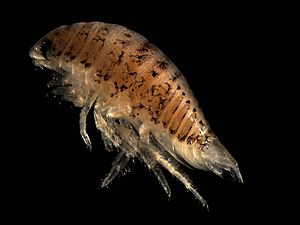Isopod facts for kids
Quick facts for kids IsopodaTemporal range: Carboniferous (300 - 0 Ma)
|
|
|---|---|
 |
|
| Eurydice pulchra (Cirolanidae) | |
| Scientific classification | |
| Kingdom: | |
| Phylum: | |
| Subphylum: | |
| Class: | |
| Subclass: |
Eumalacostraca
|
| Superorder: |
Peracarida
|
| Order: |
Isopoda
Latreille, 1817
|
| Suborders | |
|
|
Isopoda is an order of crustaceans that includes woodlice and their relatives. Isopods live in the sea, in fresh water, or on land.
All have rigid, segmented exoskeletons, two pairs of antennae, seven pairs of jointed limbs on the thorax, and five pairs of branching appendages on the abdomen that are used in respiration. Females brood their young in a pouch under their thorax.
Isopods have various feeding methods: some eat dead or decaying plant and animal matter, others are grazers, or filter feeders, a few are predators, and some are internal or external parasites, mostly of fishes.
Aquatic species mostly live on the seabed or bottom of freshwater bodies of water, but some more derived taxa can swim for a short distance. Terrestrial forms move around by crawling and tend to be found in cool, moist places. Some species are able to roll themselves into a ball as a defence mechanism or to conserve moisture.
There are over 10,000 species of isopod worldwide, with around 4,500 species found in marine environments, mostly on the seabed, 500 species in fresh water, and another 5,000 species on land. The fossil record of isopods dates back to the Carboniferous period (in the Pennsylvanian epoch), at least 300 million years ago, when isopods lived in shallow seas.
The majority of crustaceans are aquatic and the isopods are one of the few groups of which some members now live on land. The only other crustaceans which include a small number of terrestrial species are amphipods (like sandhoppers) and decapods (crabs, shrimp, etc.). Terrestrial isopods play an important role in many tropical and temperate ecosystems by aiding in the decomposition of plant material through mechanical and chemical means, and by enhancing the activity of microbes. The woodlice, suborder Oniscidea, are the most successful group of terrestrial crustaceans and show various adaptations for life on land.
They are subject to evaporation, especially from their ventral area, and as they do not have a waxy cuticle, they need to conserve water, often living in a humid environment and sheltering under stones, bark, debris or leaf litter. Desert species are usually nocturnal, spending the day in an underground burrow and emerging at night. Moisture is obtained through food sources or by drinking, and some species can form their paired uropodal appendages into a tube and funnel water from dewdrops onto their pleopods.
Many species can roll themselves into a ball, a behaviour used in defence that also conserves moisture. Members of the families Ligiidae and Tylidae, commonly known as rock lice or sea slaters, are the least specialised of the woodlice for life on land. They inhabit the splash zone on rocky shores, jetties and pilings, may hide under debris washed up on the shore and can swim if immersed in water.
Related pages
Images for kids
-
The woodlouse Oniscus asellus showing the head with eyes and antennae, carapace and relatively uniform limbs





